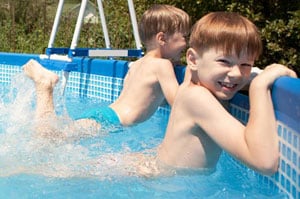Are You Putting Your Kids at Risk of Drowning
Approximately 525 Canadians will drown this year across the country according to the Red Cross. This fact is based on a Canadian Red Cross report regarding water-fatalities compiled over a 20 year period. The report found Canadians are not taking proper precautions to protect their families around backyard pools. Alarmingly, 11% of Canadians indicated they were doing nothing to prevent access to the pool for children under 10.
At the beginning of every summer, the Red Cross aims to educate Canadians about water safety and preventing drowning fatalities. The twenty year report reveals some eye-opening statistics about drowning.
- More than 50% of water-related deaths occur in the summer months of June, July and August.
- 20% of drownings are due to unexpected falls into water. Dozens of Canadians are injured or drown during activities where they never expected to enter the water.
- Over 60% of incidents occurred while Canadians were engaged in recreational activities.
- 80% of fatalities among children occurred when there was no adult supervision.
- Children aged 1 – 4 and men 15 – 34 were the two groups at highest risk of drowning.
Often the risk of water-related injury and death when on or near water is far greater than perceived. For this reason it is important to take proper precautions in and around water. Children should never be left unsupervised around water. Everyone should learn to swim, have water safety knowledge and learn lifesaving skills like CPR.
A misconception about drowning is that a person who is in trouble will make splashing noises and call for help but often drowning is silent and very quick. A small child can disappear in seconds and can drown in just a few centimeters of water. Typically child deaths occur in backyard pools, toddler pools, ponds, the bathtub, or at the beach.
It is critical that adults never let their guard down when children are around water. This means that an adult must always focus on actively watching children to prevent drowning. A supervising adult must know how to swim and should never be distracted by anything including a text message, a ringing phone or entertaining guests.
A significant number of deaths involved boats with alcohol contributing to at least 39% of boating-related deaths.
Lifejackets save lives but were unfortunately worn properly only in 12% of boating-related deaths. In 21% of cases a lifejacket was present on board but was not worn. When worn properly, a lifejacket will keep a person who falls unexpectedly into water at the surface.
Make your family’s summer an enjoyable and safe one by watching them closely in around water and learning how to swim. Learning to swim is a life skill for everyone. It’s never too late to learn how to swim. For more information on swimming lessons in your area, visit www.redcross.ca.


